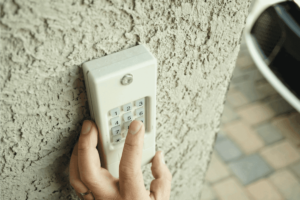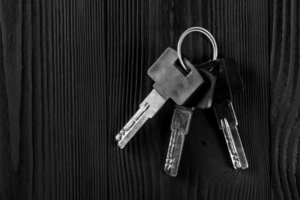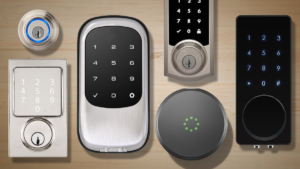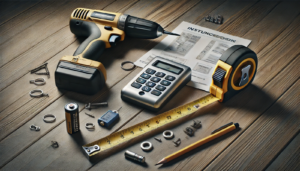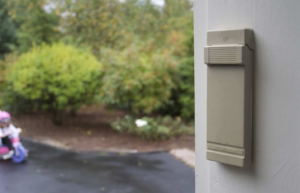Is your Roseville, CA, garage door keypad not working? Follow our troubleshooting guide to identify common issues and restore functionality quickly.
A garage door keypad is a convenient way to enhance the security and accessibility of your home without the need for physical keys or remotes. With just a code, you can open and close your garage door, making it easier for family members or guests to enter without carrying an extra device. Whether you’re upgrading your system or installing one for the first time, a garage door keypad adds a layer of simplicity to your daily routine.
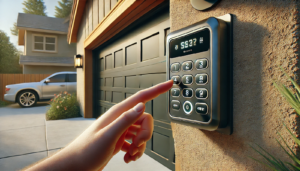
This guide covers everything you need to know, from installation to the key benefits of using a keypad. You’ll also find tips on troubleshooting common issues and maintaining the keypad to ensure it lasts for years.
Keep reading to discover how a garage door keypad can transform your garage access into a seamless, secure experience!
What is a Garage Door Keypad?
A garage door keypad is a small, battery-operated device installed outside the garage door that allows you to open or close your garage by entering a unique code. Keypads are typically installed on the garage frame or wall, providing a secure, keyless entry method for homeowners and authorized users.
How Do Keypads Work?
Garage door keypads are connected wirelessly to the garage door opener system. When you enter your access code, the keypad sends a signal to the opener, activating the garage door mechanism. These devices often have additional security features, such as temporary codes for visitors and lockout modes to prevent unauthorized access.
Types of Garage Door Keypads
There are a few different types of keypads available, each offering unique features:
- Wireless Keypads: Most modern keypads are wireless, allowing for easy installation and connectivity to the garage door opener. They run on batteries and connect directly to the opener’s receiver.
- Hardwired Keypads: These are less common but offer a more reliable connection because they are directly wired to the opener. They typically require a professional installation.
- Universal Keypads: Universal keypads are compatible with a wide range of garage door openers, making them ideal if you want a flexible option for various brands or models.
Benefits of Using a Garage Door Keypad
A garage door keypad offers several benefits, making it a popular choice among homeowners who want enhanced security and convenience. Here’s why investing in a keypad could be an excellent decision for your garage door system.
1. Enhanced Security and Keyless Access
Garage door keypads provide a secure way to enter your home without needing keys or remotes, which can be lost or stolen. You can create a unique access code that only you and trusted individuals know, providing an added layer of security.
- Temporary Access Codes: Many keypads allow you to create temporary access codes for guests or service providers. This feature is handy if you need to grant access to your garage while you’re away.
- Lockout Mode: Some keypads offer a lockout mode that temporarily disables the keypad after several failed attempts. This feature helps prevent unauthorized access.
2. Convenience and Flexibility
With a garage door keypad, you won’t need to carry an extra remote control or fumble for keys when you’re on the go. Simply enter your code, and the garage door will open. This feature benefits families with multiple members who need to access the garage.
- Remote-Free Access: A keypad allows you to operate the garage door without a remote, making it easier to access your garage while walking the dog, jogging, or returning home after a bike ride.
- Access for Kids and Visitors: Kids coming home from school or family members visiting don’t need a remote. They can use the code to enter, and you can change the code anytime for added security.
3. Weather-Resistant and Durable Design
Garage door keypads are designed to withstand outdoor conditions like rain, snow, and extreme temperatures. Most keypads are weather-resistant and made of durable materials, so you can count on reliable performance throughout the year.
4. Compatibility with Smart Home Systems
Modern keypads integrate seamlessly with smart home systems, allowing you to operate the garage door through a mobile app or voice assistant. This compatibility adds convenience and control, as you can open or close the door remotely, monitor activity, and receive alerts for added security.
How to Choose the Right Garage Door Keypad
Selecting the right garage door keypad involves evaluating your specific needs and preferences. Here are some factors to consider:
1. Compatibility with Your Garage Door Opener
Not all keypads are compatible with every type of garage door opener. Before purchasing, confirm that the keypad you’re considering works with your garage door opener’s brand and model. Many manufacturers offer universal keypads compatible with various opener systems, while others are brand-specific.
2. Range and Connectivity
If you have a large property or a detached garage, the keypad’s wireless signal range must be considered. Look for models with a strong signal to ensure reliable connectivity between the keypad and the opener, even from a distance.
3. Battery Life and Power Source
Most wireless keypads operate on batteries, so consider battery life when choosing a model. Some keypads feature low-battery indicators, alerting you when it’s time for a replacement. If you prefer a hardwired option, ensure it’s compatible with your setup and consider professional installation.
4. Security Features
Look for keypads that offer advanced security features, such as temporary codes, lockout mode, or one-touch operation. These features can enhance your keypad’s functionality and make it more secure against unauthorized access.
5. Ease of Installation
Some keypads come with simple, DIY-friendly instructions, while others may require professional installation. If you prefer to install it yourself, look for a model with straightforward instructions and minimal tools needed.
Step-by-Step Guide to Installing a Garage Door Keypad
Installing a garage door keypad is a relatively simple process that many homeowners can handle independently. Follow these steps to set up your new keypad and enjoy the convenience of keyless entry.
Step 1: Choose the Installation Location
Select a location on the garage door frame or wall near the garage where it’s easily accessible but out of reach of children. The keypad should be at a comfortable height and away from areas where it might be exposed to excessive rain or direct sunlight.
Step 2: Program the Keypad
Follow the manufacturer’s instructions to program the keypad with your garage door opener. This typically involves entering a specific code sequence on the keypad and pressing the “learn” button on your garage door opener unit. Ensure the code is unique and easy for you to remember but difficult for others to guess.
Step 3: Mount the Keypad
Use the screws or mounting hardware provided to secure the keypad in place. Most keypads require just two screws, making the installation quick and straightforward. Ensure the keypad is securely mounted, as a loose installation could affect its performance.
Step 4: Test the Keypad
Test the keypad by entering your access code once the keypad is programmed and mounted. The garage door should open and close as expected. If it doesn’t work, check the keypad’s programming instructions and ensure you followed all steps correctly.
Step 5: Set Up Additional Features
If your keypad offers additional features, such as temporary codes or a lockout mode, take a few moments to set them up. Familiarize yourself with these features to maximize your keypad’s functionality and security.
Troubleshooting Common Garage Door Keypad Issues
While garage door keypads are generally reliable, you may occasionally encounter issues. Here are some common problems and solutions to help you troubleshoot:
1. Keypad Not Responding
If your keypad doesn’t respond when you enter your code, check the battery and replace it if necessary. A depleted battery is one of the most common causes of keypad malfunctions. If the battery is fine, try reprogramming the keypad.
2. Keypad Won’t Pair with the Garage Door Opener
If the keypad isn’t pairing with the opener, double-check that you followed the programming instructions correctly. Ensure the keypad is compatible with your opener, and make sure you press the “learn” button on the opener unit.
3. Code Not Working
If your access code isn’t working, it may have been accidentally reset or corrupted. Reprogram the keypad with a new code and test it to confirm that the new code works. If the problem persists, refer to the manufacturer’s troubleshooting guide.
4. Limited Range or Poor Connectivity
If your keypad has a limited range or frequently disconnects, check for potential sources of interference, such as large metal objects, that could block the signal. If the keypad is too far from the opener, consider relocating it to improve signal strength.
5. Stuck or Unresponsive Buttons
Keypad buttons can wear out over time, especially in extreme weather conditions. Try cleaning the keypad with a soft, damp cloth if the buttons are stuck or unresponsive. Avoid using harsh chemicals, as they could damage the keypad’s surface.
Maintaining Your Garage Door Keypad
Routine maintenance can help extend the life of your garage door keypad and ensure it continues to work efficiently. Here are some tips for keeping your keypad in good condition:
1. Clean the Keypad Regularly
Dust and grime can accumulate on the keypad, affecting the buttons’ responsiveness. To remove buildup, clean the keypad with a soft, damp cloth every few months. Avoid using abrasive cleaners or excessive water, as these can damage the keypad.
2. Replace Batteries as Needed
Battery life varies depending on usage and the keypad model. Replace the batteries at least once a year or whenever the keypad becomes less responsive. Some keypads have low-battery indicators, so look for these warnings.
3. Inspect the Keypad for Damage
Check the keypad for signs of wear, such as cracked buttons or faded numbers. If you notice damage, consider replacing the keypad to maintain optimal performance and security.
4. Reprogram as Needed
Over time, you may wish to change your access code for security reasons. Familiarize yourself with the reprogramming process to easily update your code whenever necessary. Regularly changing the code can help protect against unauthorized access.
5. Protect from Extreme Weather
While most keypads are weather-resistant, extreme temperatures or direct sunlight can affect performance over time. Install a small cover or shade if your keypad is exposed to the elements, or look for models specifically designed to withstand harsh weather conditions.
Common Questions about Garage Door Keypad
How long do keypads last?
Most garage door keypads last between 5 and 10 years, depending on usage and exposure to weather. To maximize the lifespan, keep the keypad clean, change the battery annually, and protect it from extreme temperatures. Proper care helps ensure reliable performance and reduces the need for frequent replacements.
Which is better: wired or wireless garage door keypad?
Wireless keypads are generally preferred for their easy installation and flexibility, as they don’t require wiring and can be placed anywhere within range. Wired keypads offer consistent power without needing batteries, making them reliable. The best choice depends on your preferences for convenience and whether you’re comfortable changing batteries periodically.
Are outdoor garage door keypads safe?
Yes, outdoor garage door keypads are safe. They are designed to withstand weather conditions and include security features like encryption. To enhance safety, choose a keypad with a cover to protect it from rain and dust. Changing your access code regularly also adds an extra layer of security.
How long do keypad garage door openers last?
Keypad garage door openers typically last 5 to 10 years and are regularly used and maintained. The opener’s longevity depends on the device’s quality, how frequently it’s used, and exposure to the elements. Battery replacements and occasional reprogramming can extend its lifespan.
Can a garage door keypad be replaced?
Yes, a garage door keypad can be easily replaced. Simply remove the old keypad, install the new one according to the manufacturer’s instructions, and reprogram it to your garage door opener. Most new keypads come with detailed setup guides, making replacement a straightforward process for most homeowners.
Conclusion
A garage door keypad adds convenience, security, and flexibility to your garage door system. By choosing the right model, installing it correctly, and following a few simple maintenance steps, you can enjoy the benefits of keyless entry for years to come. Whether you’re upgrading your current system or adding a keypad for the first time, this guide provides all the information you need to make an informed decision. With regular care and attention, your garage door keypad will be a valuable asset to your home’s security and accessibility.
End Note
When your garage door keypad stops working, it can be a real hassle. At Perfect Solutions Garage Door Inc., we specialize in fast and efficient garage door keypad repairs and installations to restore your door’s functionality. Whether you need a new keypad installed or an existing one repaired, our team is here to help. We also handle a range of other garage door services, from opener repairs to full-door installations. We work with top brands like Amarr, Wayne Dalton, CHI, and Clopay, so you can trust the quality of our products.
We’re also proud to offer Liftmaster openers, which provide excellent durability and ease of use. Explore our gallery or visit our projects page to see our work. Learn more about our services here, or contact us for immediate assistance. Don’t forget to visit our blog for tips on maintaining your garage door keypad and more.

